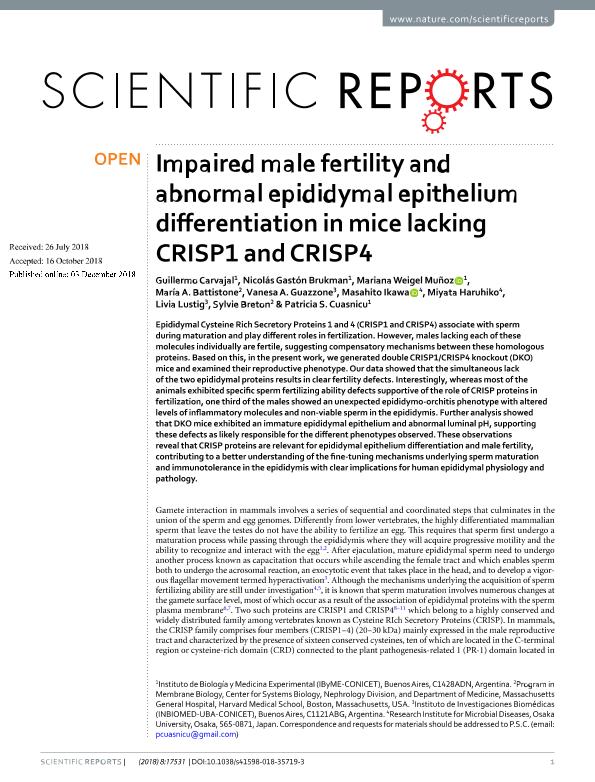Mostrar el registro sencillo del ítem
dc.contributor.author
Carvajal, Guillermo

dc.contributor.author
Brukman, Nicolás Gastón

dc.contributor.author
Weigel Muñoz, Mariana

dc.contributor.author
Battistone, Maria Agustina

dc.contributor.author
Guazzone, Vanesa Anabella

dc.contributor.author
Ikawa, Masahito
dc.contributor.author
Haruhiko, Miyata
dc.contributor.author
Lustig, Livia

dc.contributor.author
Breton, Sylvie
dc.contributor.author
Cuasnicu, Patricia Sara

dc.date.available
2019-10-22T17:34:19Z
dc.date.issued
2018-12
dc.identifier.citation
Carvajal, Guillermo; Brukman, Nicolás Gastón; Weigel Muñoz, Mariana; Battistone, Maria Agustina; Guazzone, Vanesa Anabella; et al.; Impaired male fertility and abnormal epididymal epithelium differentiation in mice lacking CRISP1 and CRISP4; Nature Publishing Group; Scientific Reports; 8; 1; 12-2018; 1-19
dc.identifier.issn
2045-2322
dc.identifier.uri
http://hdl.handle.net/11336/86913
dc.description.abstract
Epididymal Cysteine Rich Secretory Proteins 1 and 4 (CRISP1 and CRISP4) associate with sperm during maturation and play different roles in fertilization. However, males lacking each of these molecules individually are fertile, suggesting compensatory mechanisms between these homologous proteins. Based on this, in the present work, we generated double CRISP1/CRISP4 knockout (DKO) mice and examined their reproductive phenotype. Our data showed that the simultaneous lack of the two epididymal proteins results in clear fertility defects. Interestingly, whereas most of the animals exhibited specific sperm fertilizing ability defects supportive of the role of CRISP proteins in fertilization, one third of the males showed an unexpected epididymo-orchitis phenotype with altered levels of inflammatory molecules and non-viable sperm in the epididymis. Further analysis showed that DKO mice exhibited an immature epididymal epithelium and abnormal luminal pH, supporting these defects as likely responsible for the different phenotypes observed. These observations reveal that CRISP proteins are relevant for epididymal epithelium differentiation and male fertility, contributing to a better understanding of the fine-tuning mechanisms underlying sperm maturation and immunotolerance in the epididymis with clear implications for human epididymal physiology and pathology.
dc.format
application/pdf
dc.language.iso
eng
dc.publisher
Nature Publishing Group

dc.rights
info:eu-repo/semantics/openAccess
dc.rights.uri
https://creativecommons.org/licenses/by-nc-sa/2.5/ar/
dc.subject
FERTILITY
dc.subject
EPIDIDYMAL
dc.subject
CRISP
dc.subject
SPERM
dc.subject.classification
Biología Reproductiva

dc.subject.classification
Ciencias Biológicas

dc.subject.classification
CIENCIAS NATURALES Y EXACTAS

dc.title
Impaired male fertility and abnormal epididymal epithelium differentiation in mice lacking CRISP1 and CRISP4
dc.type
info:eu-repo/semantics/article
dc.type
info:ar-repo/semantics/artículo
dc.type
info:eu-repo/semantics/publishedVersion
dc.date.updated
2019-10-15T19:39:37Z
dc.identifier.eissn
2045-2322
dc.journal.volume
8
dc.journal.number
1
dc.journal.pagination
1-19
dc.journal.pais
Reino Unido

dc.journal.ciudad
Londres
dc.description.fil
Fil: Carvajal, Guillermo. Consejo Nacional de Investigaciones Científicas y Técnicas. Instituto de Biología y Medicina Experimental. Fundación de Instituto de Biología y Medicina Experimental. Instituto de Biología y Medicina Experimental; Argentina
dc.description.fil
Fil: Brukman, Nicolás Gastón. Consejo Nacional de Investigaciones Científicas y Técnicas. Instituto de Biología y Medicina Experimental. Fundación de Instituto de Biología y Medicina Experimental. Instituto de Biología y Medicina Experimental; Argentina
dc.description.fil
Fil: Weigel Muñoz, Mariana. Consejo Nacional de Investigaciones Científicas y Técnicas. Instituto de Biología y Medicina Experimental. Fundación de Instituto de Biología y Medicina Experimental. Instituto de Biología y Medicina Experimental; Argentina
dc.description.fil
Fil: Battistone, Maria Agustina. Massachusetts General Hospital; Estados Unidos
dc.description.fil
Fil: Guazzone, Vanesa Anabella. Consejo Nacional de Investigaciones Científicas y Técnicas. Oficina de Coordinación Administrativa Houssay. Instituto de Investigaciones Biomédicas. Universidad de Buenos Aires. Facultad de Medicina. Instituto de Investigaciones Biomédicas; Argentina
dc.description.fil
Fil: Ikawa, Masahito. Osaka University; Japón
dc.description.fil
Fil: Haruhiko, Miyata. Osaka University; Japón
dc.description.fil
Fil: Lustig, Livia. Consejo Nacional de Investigaciones Científicas y Técnicas. Oficina de Coordinación Administrativa Houssay. Instituto de Investigaciones Biomédicas. Universidad de Buenos Aires. Facultad de Medicina. Instituto de Investigaciones Biomédicas; Argentina
dc.description.fil
Fil: Breton, Sylvie. Massachusetts General Hospital; Estados Unidos
dc.description.fil
Fil: Cuasnicu, Patricia Sara. Consejo Nacional de Investigaciones Científicas y Técnicas. Instituto de Biología y Medicina Experimental. Fundación de Instituto de Biología y Medicina Experimental. Instituto de Biología y Medicina Experimental; Argentina
dc.journal.title
Scientific Reports
dc.relation.alternativeid
info:eu-repo/semantics/altIdentifier/url/https://www.nature.com/articles/s41598-018-35719-3
dc.relation.alternativeid
info:eu-repo/semantics/altIdentifier/doi/http://dx.doi.org/10.1038/s41598-018-35719-3
dc.relation.alternativeid
info:eu-repo/semantics/altIdentifier/url/https://www.ncbi.nlm.nih.gov/pmc/articles/pmid/30510210/
Archivos asociados
